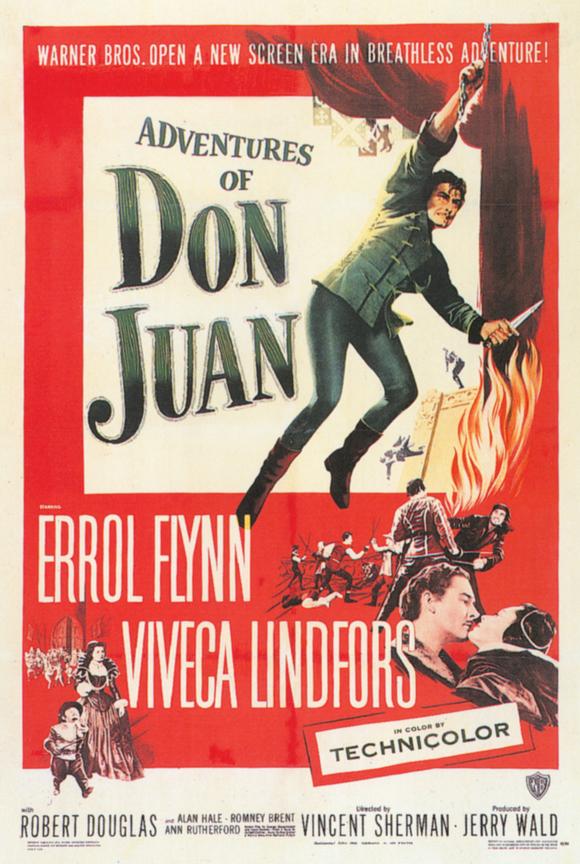 After passing a few other, earlier Errol Flynn titles, Barbara has finally selected one, the last real swashbuckler which Flynn made, the very entertaining Adventures of Don Juan (1948). By the time he made Don Juan Flynn was no longer in prime shape, in body or face, and the film is negatively impacted because of it. Even so, it is a witty satire of the Don Juan legend, and of Errol Flynn’s bawdy screen persona. The script had undergone several rewrites, including tinkering by Max Brand and William Faulkner, and Warner Bros. seems to have kept the best bits by everyone involved.
After passing a few other, earlier Errol Flynn titles, Barbara has finally selected one, the last real swashbuckler which Flynn made, the very entertaining Adventures of Don Juan (1948). By the time he made Don Juan Flynn was no longer in prime shape, in body or face, and the film is negatively impacted because of it. Even so, it is a witty satire of the Don Juan legend, and of Errol Flynn’s bawdy screen persona. The script had undergone several rewrites, including tinkering by Max Brand and William Faulkner, and Warner Bros. seems to have kept the best bits by everyone involved.
While other actors may have rivaled Flynn as romantic leads, few if any boasted his athletic grace and charm. When one thinks of a “swashbuckler,” — a swaggering soldier, adventurer or daredevil — one thinks of Errol Flynn first and foremost. Flynn was not the first of the screen’s sword-wielding heroes but he very quickly became the best that the sound era had to offer. His personality was exactly right for the heady mix of beefcake and bravado these films required, and Flynn’s charm and humility did the rest. He was a remarkable movie star, and a pretty fair actor when asked to flex those muscles, too.
The role of Don Juan would seem right up Flynn’s alley, and it would have been if the film had been made a decade earlier, as it was originally scheduled to be. But by 1947 Flynn’s star was fading from a life perhaps too well led, a scandalous 1943 rape trial and several years of roles more dramatic than physical. Nevertheless, Flynn was the only choice for Don Juan and he essays the role with not only the requisite romanticism but an astute sense of nostalgic ennui, conveying with a wink and a rueful smile that Don Juan realizes his best days are behind him.
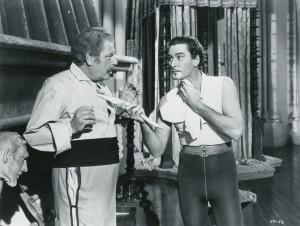
Adventures of Don Juan finds the middle-aged Don Juan de Marana (Errol Flynn) in London with his friend Leporello (Alan Hale), looking for love in all the wrong places. A public disgrace has him sent back to Madrid to serve Queen Margaret (Viveca Lindfors). She assigns him to work as a fencing master, at which he excels, yet Don Juan remains troubled by the changes he sees in Spain. King Philip III (Romney Brent) is easily manipulated by the Duke de Lorca (Robert Douglas), an aristocrat who wishes to become the real power behind the throne. A clash is inevitable, finally occurring when Don Juan learns that de Lorca has unjustly, secretly imprisoned his friend Count de Polan (Robert Warwick). Don Juan and his fencing students take action, hoping to save Queen Margaret before de Lorca can have her removed and consolidate his position as the king’s greatest influence.
Anyone expecting ribald romantic adventures (hinted by the title) involving Don Juan and his many lady friends is bound to be disappointed. He has only four affairs, all quite modest. In England Don Juan dallies with Catherine (Mary Stuart), although his powers of conquest are well demonstrated. Don Juan: “I have loved you since the beginning of time.” Catherine: “But you only met me yesterday!” Don Juan: “Well, that is when time began.” Their clinches are interrupted by the arrival of her husband, and Don Juan’s subsequent sojourn to London, where he is mistaken for a Spanish duke, to be married to Diana (Helen Westcott), as a pact to prevent war between Spain and England. But Diana knows Don Juan from Paris . . .
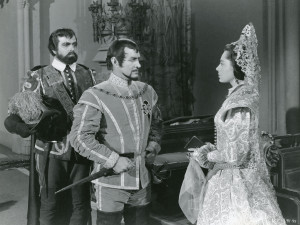
In Spain, Don Juan learns the meaning of true love when he sets eyes on Queen Margaret (Viveca Lindfors), yet she is unattainable in every respect. Treating him gently at the urging of Count de Polan, she imbues in him a dedication and patriotism he did not know he could ever feel. Don Juan behaves himself for the queen, and she eventually finds affection for him, despite her misgivings. Don Juan’s other dalliance is with Donna Elena (Ann Rutherford), who ingratiates herself into his company after the fencing demonstration. She wants one night of passion before marrying a count for the good of the country. But the count arrives and Don Juan cannot escape without a further disgrace. None of these encounters is overtly sexual, and none of them progress further than some kissing before interruption.
Instead, the story delves into court intrigue as de Lorca makes his move against King Philip and imprisons Don Juan. It is up to Don Juan to escape, and with the help of Leporello, other friends and the fencing students to foil the plans of de Lorca and rescue Queen Margaret before she is to be executed. A chief ally is the king’s favorite, the diminutive Don Sebastian (Jerry Austin), who takes a liking to Don Juan the minute they meet. It is Don Sebastian who continually watches over the queen, for whom he would sacrifice everything. Even as the revolt explodes into action, Don Sebastian sets himself to protect the queen.
The film bogs down a bit as the intrigue overtakes the action, until a final sequence on the palace steps pits Don Juan against de Lorca once and for all. This is as close to the glory days of Flynn’s career as the film gets — and it is stuntman Jock Mahoney, not Flynn, who leaps from the tenth step onto de Lorca to kill him. “The sword is not for a traitor,” pants Don Juan, tossing it away, then making his leap. “You die by the knife!” A denouement in which Don Juan explains why he must leave to the queen follows, in order to cement the legend in the minds of the audience, and then a final coda, wherein Don Juan regains his normal swagger. A coach passes and a beautiful woman catches his eye. So much for studying at the University. He tells faithful Leporello, “My dear friend, there’s a little bit of Don Juan in every man. And since I am Don Juan, there must be more of it in me.” With that, the duo follow the coach. Incidentally, the woman in the coach is Nora Eddington, Flynn’s wife at the time.
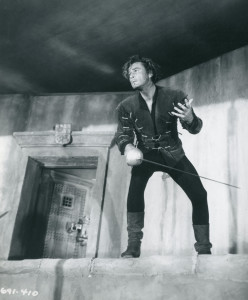
It is the writing, credited to George Oppenheimer and Harry Kurnitz (and aided, uncredited by Brand, Faulkner and Robert Florey, that makes this adventure so witty and entertaining. Don Juan is not a braggart but a humble man searching for happiness. The women are not unwary victims but lonely wives or brides-about-to-be wanting a few moments of passion to remember for the rest of their lives. Duke de Lorca is a despicable despot but he is impeccably polite and witty in his own way. Don Sebastian, the dwarf, is the court jester but he is also the conscience of the picture. Wisdom and wit combine in this terrific script to frame the story of a man, hostage to his own reputation, finally finding his destiny. It’s a little too obvious at the end, when Don Juan has to explain to Queen Margaret why he cannot stay, yet it is good to hear Don Juan actually saying, and meaning, the words that we weren’t sure he could ever utter. The script is why this movie stays fresh and compelling almost seventy years after its release.
Vincent Sherman’s direction is fine, if not stylish nor spectacular. He may have been hindered by the demands of Technicolor (heavy, bulky cameras, the need for very bright lighting, etc.), and Errol Flynn’s wandering ways didn’t help matters. Then just 38, Flynn still loved to live the high life, but he couldn’t control his excesses as well. He tired easily, which is especially noticeable during the sword-fighting scenes, and couldn’t sustain long passages of dialogue. It’s quite remarkable that Flynn carries the picture as well as he does, considering his circumstances. His age actually works in favor of the script’s nostalgia quotient, and he was professional enough to enact the role to his capabilities.
Adventures of Don Juan had been scheduled for production in 1939 and again in 1945, but circumstance, a labor strike and illness forced the production back and back again. When Warner Bros. finally committed its resources to the project, it did so whole hog, with expensive Technicolor, more than five thousand costumes and a full symphonic score by Max Steiner (Erich Wolfgang Korngold had recently retired). The result is a film intended to reestablish Flynn as a romantic action star. In that regard it largely failed; the film did only moderately well in America and future Flynn projects suffered smaller budgets because of this film’s commercial disappointment.
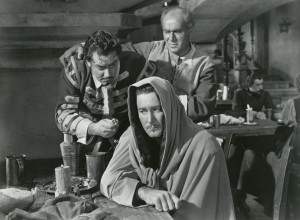
The film also contains a few surprises here and there. Besides the appearance of Flynn’s second (and current) wife Nora Eddington at the end, it also boasts the presence of Raymond Burr as a sadistic soldier, Captain Alvarez. That’s Una O’Connor as Lady Diana’s faithful Duenna, while Barbara Bates appears as the innkeeper’s daughter (and whose mother calls her a hussy when she notes how much she would like to meet the legendary Don Juan). This film marked the thirteenth — and final — teaming of Flynn and Alan Hale. Hale died in 1950. And if one looks fast, one can see certain shots from The Adventures of Robin Hood and The Private Lives of Elizabeth and Essex that have been matched to the print in the nighttime escape and daytime procession sequences.
As noted earlier the film was not a big hit in America, failing to earn back its $3.5 million budget (it was originally $2 million). It was popular overseas, but this was not enough to convince Warner Bros. to spend that much on another Flynn vehicle. Initially released in December 1948 it garnered two Academy Award nominations, for Costume Design, Color (which it won) and Art Direction-Set Decoration, Color (which it lost to Little Women). But wait, you say, if you are an Oscar buff. Wasn’t Little Women a 1949 title? Yes! For some reason Adventures of Don Juan was considered for the 1949 awards even though it debuted in 1948.
Is Adventures of Don Juan a classic? I think it’s a borderline case, and now I would have to vote no. The first time I saw it, quite a few years ago, I truly enjoyed it and rated it ☆ ☆ ☆ 1/2. Back then, I would have said yes. Now, having seen Flynn on his downward descent as an action star, I am not as impressed. I still like the film and do recommend it, but I don’t think it is good enough to be considered a classic. It isn’t fresh or revelatory or important in any major way. It’s just a good studio film, an entertaining way to spend two hours, somewhat nostalgic, somewhat exciting and somewhat sad. Good studio films may be a rarity now but they were common in the golden days of Hollywood, and this is a fine example. Classics are those films which promise — and deliver — a bit more than others. My verdict is no. ☆ ☆ ☆. 6 March 2016.
